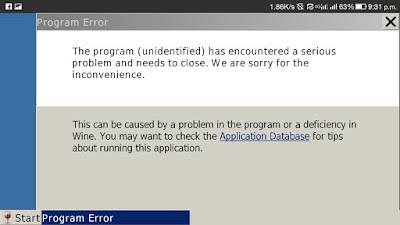The title seemed like it's reverse. Didn't it? haha
Yes, I'm not talking about running Android apps in Windows, I'm talking about running Windows x86 apps in your Android!!!
Developers from CodeWeavers have just released version 3.0 of the Wine compatibility layer for Linux-based systems, which can now be built into an APK package and installed on your Android device. Earlier it could power Chromebooks to do the same.
Wine 3.0 release represents a year of development effort and over 6,000
individual changes. You can get the full documentation here.
Although you’ll need an x86 Android device to take full advantage of it. Wine does support ARM devices, but you can only use programs that were ported to Windows RT. You can find a few examples here. The Wine project is working on using QEMU to emulate x86 CPU instructions on ARM, but that’s not complete yet. XDA Developers forum has a list of such apps that can be run full-fledged.
"Since Wine for Android is in its early days, there are several major limitations right now. The app only fully opened on my OnePlus 5T - it crashed on my Galaxy Tab S and froze on my 2016 Pixel. The DPI scaling is also very buggy, and it's difficult to use on a touchscreen. The graphics driver doesn't support Direct3D yet, so many programs (especially games) won't work at all unless you can force them to use OpenGL." Corbin Davenport said.
Indeed, the Android implementation is very much a work in progress with the Direct3D graphics API unsupported as yet, and with limitations, to the use of the OpenGL API, the number of Windows games you'll be able to play on your Galaxy or Chromebook is likely to be underwhelming.
You can download the latest builds for your device as APKs here. You need to download either 'wine-3.0-arm' or 'wine-3.0-x86' and not the release candidate packages. Once installed, you will find a full-screen Windows display, including a Start menu, and support for audio and basic graphics.
It's ostensibly not a full-blown emulator. However you can give a whirl to see how it works. :-) Thanks.
So let's try it out.
I'm using LeEco Le Max 2 which is powered by Snapdragon 820 MSM8996 with ARMV8I kernel architecture.
Installing Wine:
I got the package for my device from APKMirror. Obtain your suitable package to your needs.
Now let's run our pre-downloaded real Notepad++ executable.
Feel free to comeback and check out as I'm keeping this article up-to-date intermittently. :-)
Let me know in the comments if you find one, of course. Thanks.
Yes, I'm not talking about running Android apps in Windows, I'm talking about running Windows x86 apps in your Android!!!
Developers from CodeWeavers have just released version 3.0 of the Wine compatibility layer for Linux-based systems, which can now be built into an APK package and installed on your Android device. Earlier it could power Chromebooks to do the same.
Wine 3.0 release represents a year of development effort and over 6,000
individual changes. You can get the full documentation here.
 |
| Image source :Android Police |
Although you’ll need an x86 Android device to take full advantage of it. Wine does support ARM devices, but you can only use programs that were ported to Windows RT. You can find a few examples here. The Wine project is working on using QEMU to emulate x86 CPU instructions on ARM, but that’s not complete yet. XDA Developers forum has a list of such apps that can be run full-fledged.
"Since Wine for Android is in its early days, there are several major limitations right now. The app only fully opened on my OnePlus 5T - it crashed on my Galaxy Tab S and froze on my 2016 Pixel. The DPI scaling is also very buggy, and it's difficult to use on a touchscreen. The graphics driver doesn't support Direct3D yet, so many programs (especially games) won't work at all unless you can force them to use OpenGL." Corbin Davenport said.
Indeed, the Android implementation is very much a work in progress with the Direct3D graphics API unsupported as yet, and with limitations, to the use of the OpenGL API, the number of Windows games you'll be able to play on your Galaxy or Chromebook is likely to be underwhelming.
You can download the latest builds for your device as APKs here. You need to download either 'wine-3.0-arm' or 'wine-3.0-x86' and not the release candidate packages. Once installed, you will find a full-screen Windows display, including a Start menu, and support for audio and basic graphics.
It's ostensibly not a full-blown emulator. However you can give a whirl to see how it works. :-) Thanks.
So let's try it out.
I'm using LeEco Le Max 2 which is powered by Snapdragon 820 MSM8996 with ARMV8I kernel architecture.
Installing Wine:
I got the package for my device from APKMirror. Obtain your suitable package to your needs.
So here we're trying out the acclaimed Notepad++ which was recompiled for Windows RT (Metro-UI apps for Windows 8 or later). I put it on my internal storage.
Running the emulator:
Looking at the overall UI, the look and feel does seem like the Windows classic theme with Start Menu.
 |
| Start Menu |
 |
| Window Context Menu |
 |
| Run Dialog box |
 |
| Opening storage\sdcard |
 |
| Executable selected |
There you have it.
 |
| As you can see it didn't work. :-( Probably i chose the wrong ported or for whatever reason it just didn't work out. I'm searching for an fully-working executable. |
Feel free to comeback and check out as I'm keeping this article up-to-date intermittently. :-)
Let me know in the comments if you find one, of course. Thanks.






This comment has been removed by the author.
ReplyDelete